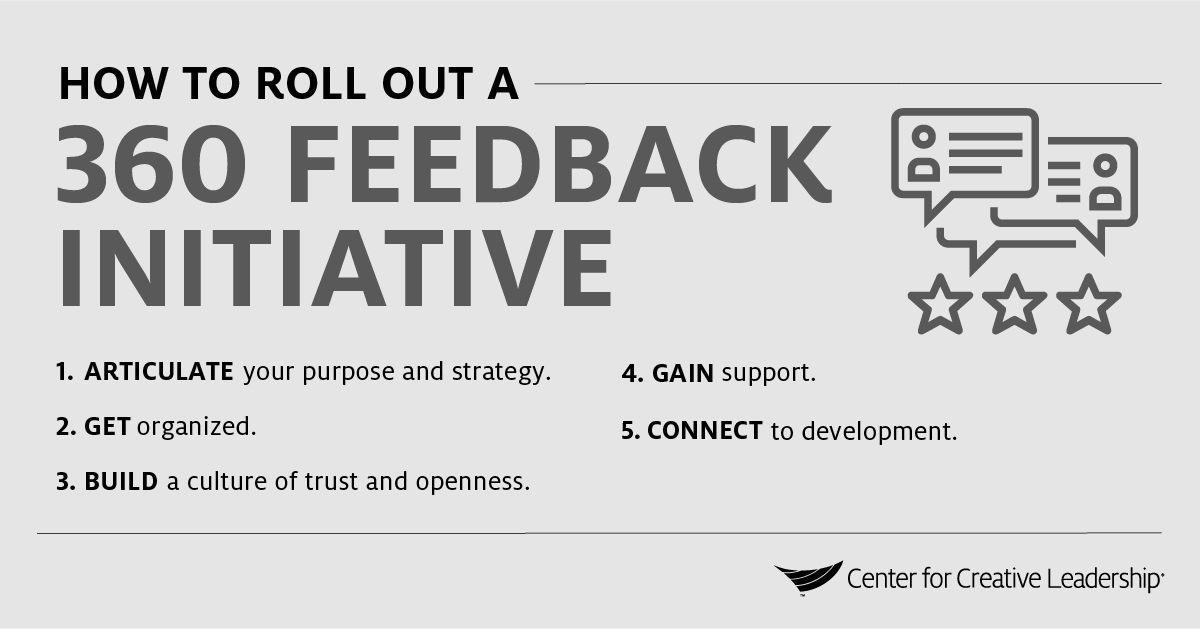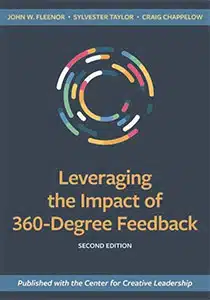Any development as a leader begins with an open and honest assessment of one’s own strengths and weaknesses.
By integrating 360 assessments into their talent management plan, organizations can help identify what’s most important to attaining their strategic goals. The successful implementation of 360 feedback assessments enterprise-wide should improve an organization’s financial performance, strengthen its existing talent, and enhance its leadership pipeline for the future.
Depending on your company, large-scale, 360 feedback at an organizational level could be the catalyst you need to align leaders, create a sense of urgency for new business strategy, and ensure quick execution. Organizational 360 degree feedback could also serve as the starting point for a successful coaching program focused on change.
How to Roll Out a Successful Organizational 360 Feedback Process
5 Steps for Success
Take the following 5 steps to successfully roll out this powerful tool for leadership development across your organization.
1. Articulate your purpose and strategy.
The use of 360s has become so pervasive these days that if your company is not currently using one, it might feel as if you’re missing out. But if you don’t make a strategic decision about what you want to accomplish with 360 feedback, you won’t know if your investment made any difference.
If you’ve heard any horror stories about 360 degree feedback initiatives that simply fell flat, know that research shows that when 360s fail, it’s usually because of botched implementation, not the tool itself. So before you start, consider how a 360 feedback initiative connects to your business strategy and to your talent strategy.
Be sure to answer these questions:
- Why do you need this? What business problem are you trying to solve, and how will a 360 help you?
- Why right now? What’s made this a priority?
- Who is it for? Who will be receiving the 360 feedback? Why is it critical that this targeted group be included to best solve your business problem?
- What outcomes do you expect from your organizational 360 feedback initiative?
You’ll want to consider and plan exactly how your HR team can use 360 feedback for development and the business.
In addition to working closely with an assessment vendor to choose the right 360 assessment for your business needs, ensure whatever assessment is selected aligns with your organization’s competency model and business outcomes.
When choosing an organizational 360 feedback provider, ask about research-based content, assessment philosophy, and the level of support that will be provided through the implementation. Senior HR leaders should define the metrics and then work with other senior executives to ensure alignment.
2. Get organized.
Implementing a 360 initiative can be a complex undertaking. Despite technological advances in data collection and reporting, a lot of people must do what they’re supposed to do for this to work well.
When you’re planning the rollout of a 360 feedback initiative, consider carefully both the “when” and the “who:”
- When: Establish a calendar, including what the milestones are and when the deadlines occur, and how individual participants can monitor their rater return rates in the process.
- Who: Consider who will fill the necessary roles, such as your contact person with the 360 vendor, your internal process administrator, and your point of contact for the participants.
You may want to start small, run a pilot, and then include larger numbers. Make sure that the first person and the last person going through the process will have the same high-quality experience.
The support of senior management is invaluable. For best results, involve them early in the process, tie the initiative to specific business goals, and ask these key stakeholders to agree to be the pilot group. They’ll help set the proper tone as they share their experiences and their 360 feedback throughout the organization. “Going first” also sends a strong signal that they respect implementing a 360 process and recognize the importance of the initiative.
If it’s not possible to start with senior management, be clear on why you’ve chosen the beginning participants. Target people who will appreciate an opportunity to receive 360 feedback.
3. Build trust.
A psychologically safe workplace with trust and openness helps people to feel secure in providing candid and authentic 360 feedback.
It’s important to create clarity from the beginning. Ensure that the outcomes are clear, and that you’ve addressed confidentiality of data and anonymity of rater responses. At CCL, our position is that the participant owns their data, and participants are encouraged to share their developmental goals with their leader. An organization does not own the individual’s assessment results, but can access a group profile.
4. Gain support.
As you plan to roll out your organizational 360 process, remember that implementing the initiative requires a strong communication plan. To create a positive, sustainable impact, be sure administrative roles and processes are clear. Create a realistic timetable, and communicate.
Simply sending bland email communications to all employees about the unveiling of a new program is ineffective. Announce your new organizational 360 feedback initiative in a compelling and unique way that fosters engagement, and look beyond just communicating about the new program. Instead, treat it as an internal marketing campaign about talent development that features several aspects of the program’s benefits.
Participants, managers, and other raters need to understand the purpose and exactly what they’re expected to do. Make sure participating individuals understand how best to approach collecting 360 feedback.
5. Connect to development.
Receiving, evaluating, and discussing a 360 feedback report is assessment. But development is what happens afterward — and development is what matters most to organizations.
For the organization and the individual to maximize the effectiveness of implementing a 360 initiative, there needs to be a process for creating a development plan, as well as support and follow-through. Make sure participants know how to understand what their 360 results really mean and have a framework for setting and achieving development goals.
You’ll maximize the ROI potential of your organizational 360 initiative if you plan for follow-up. A private one-on-one session between participants and a trained facilitator can enhance the impact of the 360 feedback process. Insightful 360 feedback, followed by or integrated with a coaching experience can reinforce development, can further extend the learning.
Access Our Webinar!
Watch our webinar, Maximizing the Impact of 360 Assessments, and get best practices and recommendations for how to roll out an effective and efficient organizational 360 process using our research-based, industry-leading instruments.
Approach the 360 Feedback Process With Credentials & Confidence
If you’re looking to implement a 360 feedback initiative at your organization, replace a current tool with a targeted or customized tool, or want to become a 360 feedback facilitator to help your participants get the most from their assessment data, our Assessment Certification Course is a smart first step.
From this course, you’ll gain the knowledge you need to design and implement a successful 360 feedback initiative. Our goal is to give you the confidence that you can do this.
Our 360 feedback certification course covers:
- How to read and interpret 360 feedback from our research-based, validated, client-tested, and industry-leading instruments, the Benchmarks® 360 assessments, and the Skillscope® leadership skills assessment.
- How to facilitate a 360 feedback session using a facilitation model that has been proven effective.
- How to successfully implement an organizational 360 feedback process, based on over 50 years of knowledge and work with clients from all over the world.
- How to link report data to an action plan that allows for targeted behavior changes.
We know you need to be wise about how you spend your training and development dollars, which is why a well-chosen, well-implemented, organizational 360 feedback initiative is one of the most powerful and cost-effective strategies for developing your leaders.
Tips for Successfully Implementing a 360 Feedback Initiative at Your Organization
Implement a successful organizational 360 process by:
- Clarify the goals for the 360 feedback initiative.
- Address individual and organization readiness.
- Design the process.
- Select or design the tool.
- Identify and prepare participants.
- Prepare the organization.
- Administer the assessment.
- Process the results and extend the learning.
For even more tips, explore our book, Leveraging the Impact of 360 Degree Feedback.
Ready to Take the Next Step?
We can partner with you to create a custom 360 feedback initiative for your organization. Learn more about designing, implementing, and facilitating 360 feedback using our world-renowned leadership assessments, and get certified to deliver them with our Assessment Certification Course, which certifies coaches, consultants, and HR leaders to facilitate our industry-leading Benchmarks® 360 assessments suite, and the straightforward and simple-to-use Skillscope® leadership skills assessment.












